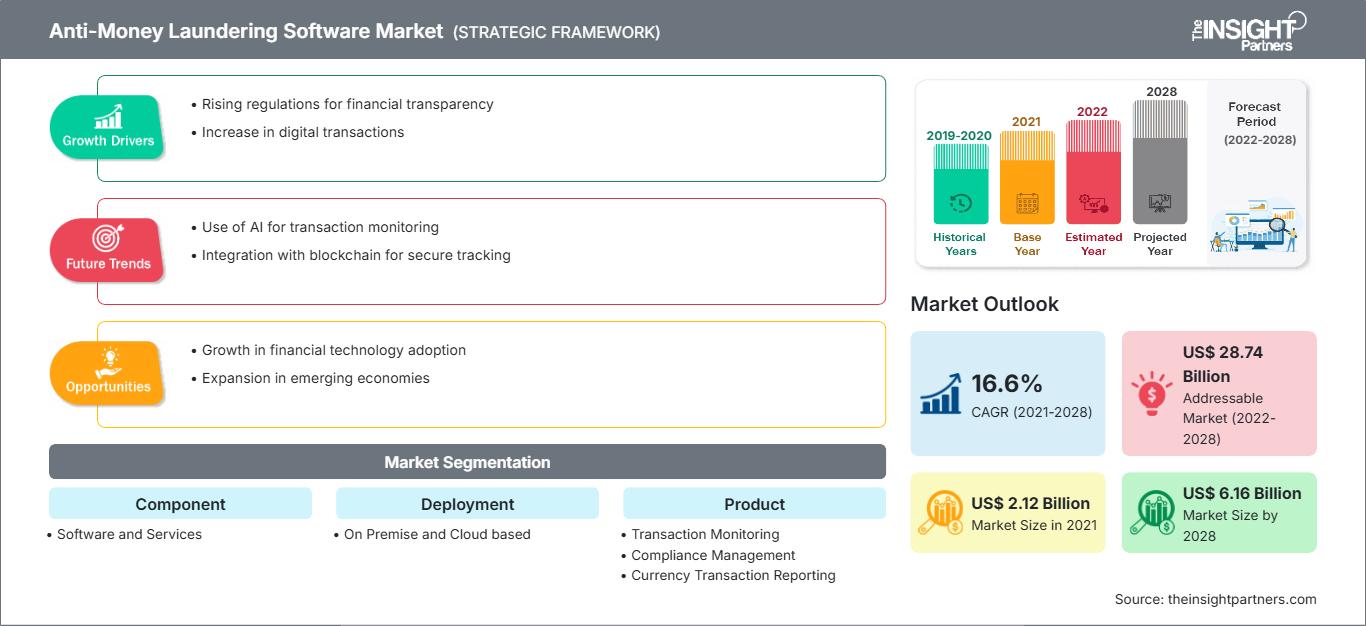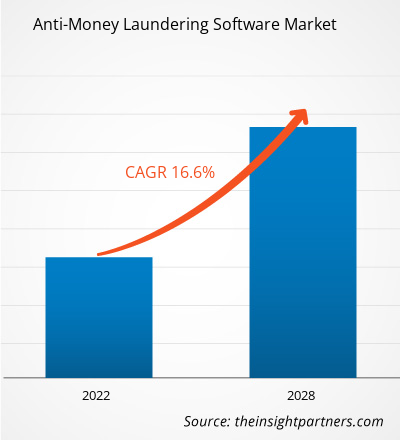[Rapporto di ricerca]Si prevede che il mercato dei software antiriciclaggio crescerà da 2.116,3 milioni di dollari nel 2021 a 6.162,8 milioni di dollari entro il 2028; si stima che il mercato dei software antiriciclaggio crescerà a un CAGR del 16,6% dal 2022 al 2028.
I progressi tecnologici stanno innescando un aumento del numero di criminali informatici. Tuttavia, le aziende FinTech hanno il potenziale per aiutare le banche di tutto il mondo a rimanere competitive sul mercato globale. L'utilizzo di sistemi più robusti, combinato con tecnologie avanzate per il tracciamento delle valute digitali, l'apprendimento automatico e la connessione dei dati, ha aperto nuove possibilità per combattere il riciclaggio di denaro. Con l'aumento dell'adozione da parte dei consumatori e il conseguente aumento dei volumi di transazioni nelle aziende FinTech competitive nel 2019, molte aziende sono passate a pratiche antiriciclaggio automatizzate. I sistemi automatizzati antiriciclaggio generano un numero trascurabile di falsi positivi rispetto a quelli generati da dati e tecnologie tradizionali. Ciò riduce gli effetti negativi dei falsi positivi, mantenendo i costi operativi entro i limiti previsti. Considerata la crescente connessione tra FinTech e soluzioni AML, a dicembre 2020 l'Associazione degli Specialisti Certificati in Antiriciclaggio ha annunciato il lancio di un nuovo programma di certificazione per le aziende FinTech che desiderano soddisfare gli standard normativi. L'associazione ha inoltre sviluppato il programma Certified AML FinTech Compliance Associate in collaborazione con FINTRAIL. Il programma è stato concepito per ampliare il kit di strumenti di conformità del personale FinTech che lavora nella prevenzione dei reati finanziari a livello di ingresso. Pertanto, la crescente attenzione delle FinTech all'implementazione di soluzioni AML sta stimolando la crescita del mercato dei software antiriciclaggio. I clienti non hanno alcun controllo sull'ubicazione dell'infrastruttura; ciò implica che, in caso di violazione del data center di un fornitore, l'azienda non avrà alcun controllo sulla durata dell'interruzione o sui dati che possono essere concessi. Tutti i clienti sui cloud condividono lo stesso pool di infrastrutture con limitate protezioni di sicurezza, configurazioni e variazioni di accessibilità. Tralasciando le limitazioni di controllo, i rischi per la sicurezza e i vincoli di policy, ci sono diverse situazioni in cui un'implementazione cloud è più adatta. Tuttavia, i cloud hanno dimensioni maggiori rispetto all'implementazione on-premise, il che consente alle aziende associate al cloud di beneficiare di una scalabilità fluida e on-demand. L'implementazione cloud è ideale per le organizzazioni che desiderano adottare soluzioni di analisi con investimenti ridotti. Consente principalmente alle aziende di acquisire i dati con tutti i loro servizi, ma a un costo contenuto.
Potrai personalizzare gratuitamente qualsiasi rapporto, comprese parti di questo rapporto, o analisi a livello di paese, pacchetto dati Excel, oltre a usufruire di grandi offerte e sconti per start-up e università
Mercato del software antiriciclaggio: Approfondimenti strategici

- Ottieni le principali tendenze chiave del mercato di questo rapporto.Questo campione GRATUITO includerà l'analisi dei dati, che vanno dalle tendenze di mercato alle stime e alle previsioni.
Impatto della pandemia di COVID-19 sul mercato dei software antiriciclaggio
La pandemia di COVID-19 ha accelerato lo sviluppo delle tecnologie digitali. A causa delle restrizioni sociali in tutto il mondo, la maggior parte delle persone ora si affida a piattaforme digitali per soddisfare le proprie esigenze quotidiane. I portafogli digitali, spesso noti come eWallet, stanno diventando sempre più popolari. Come risultato di questa transizione, la probabilità di transazioni monetarie illecite è aumentata. Il GAFI ha messo in guardia le banche dalle transazioni monetarie illecite. Di conseguenza, la domanda di soluzioni antiriciclaggio è aumentata e questo fattore ha un impatto significativo sulla crescita del mercato. A causa dell'uso diffuso delle piattaforme digitali, la quantità di dati sulle reti è in aumento, mettendo a dura prova la sicurezza delle infrastrutture di banche e istituti finanziari. Gli hacker continuano a prendere di mira le banche indipendentemente dalle numerose misure adottate. Di conseguenza, la domanda di soluzioni antiriciclaggio migliorate è in crescita. I crimini informatici, come le frodi finanziarie, sono in aumento con l'aumento dei dati sulle reti. Banche e istituti finanziari stanno ora utilizzando tecniche di analisi dei dati per migliorare le proprie procedure di sicurezza.
Regioni redditizie per il mercato dei software antiriciclaggio
Approfondimenti di mercato: mercato dei software antiriciclaggio
La crescente domanda di soluzioni sofisticate per il monitoraggio delle transazioni stimola la crescita del mercato dei software antiriciclaggio
Il monitoraggio delle transazioni è una procedura cruciale e un controllo chiave nelle politiche e procedure antiriciclaggio e di contrasto al finanziamento del terrorismo (AML/CFT) degli istituti finanziari. Le soluzioni di monitoraggio delle transazioni consentono agli istituti finanziari di rilevare e valutare se le transazioni presentano sospetti rispetto ai rispettivi profili dei clienti. Nel corso degli anni, le autorità di regolamentazione finanziaria hanno intensificato la loro attenzione sul monitoraggio delle attività a rischio antiriciclaggio, spingendo gli istituti finanziari ad adottare un adeguato processo di monitoraggio delle transazioni. Inoltre, le autorità di regolamentazione si aspettano che le aziende dimostrino la capacità e l'efficienza dei loro sistemi. La richiesta di un sofisticato sistema di monitoraggio delle transazioni è principalmente guidata dalla legislazione, come la parte 504 del Dipartimento dei Servizi Finanziari di New York, e dalla tendenza generale verso un controllo valutato in base alla qualità dei risultati. Le piattaforme software di monitoraggio delle transazioni consentono agli istituti finanziari di configurare una gamma di scenari di monitoraggio, eseguire analisi efficienti dei dati e filtrare le attività sospette reali dagli altri falsi positivi, guadagnando così una notevole popolarità sul mercato. Questo, di conseguenza, sta accelerando la domanda di soluzioni sofisticate di monitoraggio delle transazioni abilitate alla lotta al riciclaggio di denaro.
Approfondimenti sul mercato dei software antiriciclaggio basati su componenti
L'analisi del mercato dei software antiriciclaggio per componente, il mercato dei software antiriciclaggio è segmentato in software e servizi. Il segmento software ha rappresentato una quota di mercato maggiore nel software antiriciclaggio nel 2021.
Approfondimenti sul mercato dei software antiriciclaggio basati sull'implementazione
Analizzando il mercato dei software antiriciclaggio per implementazione, il mercato dei software antiriciclaggio è segmentato in cloud e on-premise. Il segmento on-premise ha rappresentato una quota di mercato maggiore nel software antiriciclaggio nel 2021. Un software antiriciclaggio basato su cloud è un modello SaaS (Software as a Service) basato sul web che utilizza la tecnologia cloud aziendale.
Approfondimenti sul mercato dei software antiriciclaggio basati sul prodotto
In base al prodotto, il mercato dei software antiriciclaggio è suddiviso in monitoraggio delle transazioni, gestione della conformità, reporting delle transazioni valutarie e gestione dell'identità del cliente. Il segmento del monitoraggio delle transazioni ha rappresentato la quota maggiore del mercato nel 2021.
Approfondimenti sul mercato dei software antiriciclaggio basati sull'utente finale
In base all'utente finale, il mercato dei software antiriciclaggio è segmentato in sanità, vendita al dettaglio, BFSI, IT e telecomunicazioni, governo e altri. Il segmento BFSI ha rappresentato la quota maggiore del mercato nel 2021. I rapidi sviluppi nelle informazioni finanziarie, nella tecnologia e nella comunicazione hanno consentito al denaro di muoversi ovunque nel mondo con velocità e facilità.
Gli operatori che operano nel mercato del software antiriciclaggio si concentrano principalmente sullo sviluppo di prodotti avanzati ed efficienti.
- A gennaio 2022, Oracle ha annunciato la sua partnership con Arachnys, per fornire la piattaforma CRI cloud-native di Arachnys da integrare e migliorare con la suite di soluzioni Financial Services Financial Crime and Compliance Management (FCCM) di Oracle.
- Ad aprile 2021, Accenture ha completato con successo l'acquisizione di Exton Consulting, una società di consulenza francese impegnata nell'offerta di supporto strategico bancario in tutta Europa.
Profilo dell'azienda:
- ACI Worldwide
- SAS Institute
- Oracle Corporation
- BAE Systems
- Accenture
- Verafin Inc.
- Safe Banking Systems LLC
- Eastnets Holding Ltd.
- Ascent Technology Consulting
- Opentext Corporation
Approfondimenti regionali sul mercato dei software antiriciclaggio
Le tendenze regionali e i fattori che influenzano il mercato dei software antiriciclaggio durante il periodo di previsione sono stati ampiamente spiegati dagli analisti di The Insight Partners. Questa sezione illustra anche i segmenti e la geografia del mercato dei software antiriciclaggio in Nord America, Europa, Asia-Pacifico, Medio Oriente e Africa, America Meridionale e Centrale.
Ambito del rapporto di mercato del software antiriciclaggio
| Attributo del rapporto | Dettagli |
|---|---|
| Dimensioni del mercato in 2021 | US$ 2.12 Billion |
| Dimensioni del mercato per 2028 | US$ 6.16 Billion |
| CAGR globale (2021 - 2028) | 16.6% |
| Dati storici | 2019-2020 |
| Periodo di previsione | 2022-2028 |
| Segmenti coperti |
By Componente
|
| Regioni e paesi coperti | Nord America
|
| Leader di mercato e profili aziendali chiave |
|
Densità degli operatori del mercato dei software antiriciclaggio: comprendere il suo impatto sulle dinamiche aziendali
Il mercato dei software antiriciclaggio è in rapida crescita, trainato dalla crescente domanda degli utenti finali, dovuta a fattori quali l'evoluzione delle preferenze dei consumatori, i progressi tecnologici e una maggiore consapevolezza dei vantaggi del prodotto. Con l'aumento della domanda, le aziende stanno ampliando la propria offerta, innovando per soddisfare le esigenze dei consumatori e sfruttando le tendenze emergenti, alimentando ulteriormente la crescita del mercato.

- Ottieni il Mercato del software antiriciclaggio Panoramica dei principali attori chiave
- Analisi storica (2 anni), anno base, previsione (7 anni) con CAGR
- Analisi PEST e SWOT
- Valore/volume delle dimensioni del mercato - Globale, Regionale, Nazionale
- Industria e panorama competitivo
- Set di dati Excel
Report recenti
Rapporti correlati
Testimonianze
Motivo dell'acquisto
- Processo decisionale informato
- Comprensione delle dinamiche di mercato
- Analisi competitiva
- Analisi dei clienti
- Previsioni di mercato
- Mitigazione del rischio
- Pianificazione strategica
- Giustificazione degli investimenti
- Identificazione dei mercati emergenti
- Miglioramento delle strategie di marketing
- Aumento dell'efficienza operativa
- Allineamento alle tendenze normative




















 Ottieni un campione gratuito per - Mercato del software antiriciclaggio
Ottieni un campione gratuito per - Mercato del software antiriciclaggio